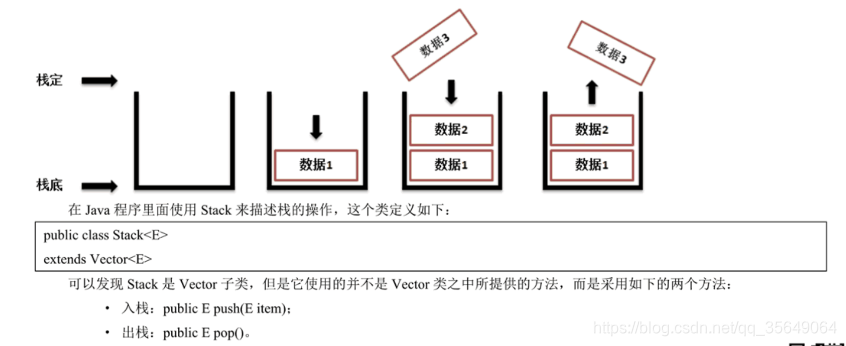Java基礎(五十九)-集合工具類(Java類集框架)
阿新 • • 發佈:2018-12-22
1:Stack棧
棧是一種先進後出的資料結構。例如:在文字編輯器上都有撤銷功能,那麼每次使用的時候,最後一次的編輯操作永遠是最先撤銷的,那麼這個功能就是利用棧來實現的,棧的基本操作形式如下。

案例:實現棧的操作
import java.util.Stack; public class JavaAPIDemo { public static void main(String[] args) throws Exception { Stack<String> all = new Stack<String>() ; all.push("A") ; all.push("B") ; all.push("C") ; System.out.println(all.pop()); System.out.println(all.pop()); System.out.println(all.pop()); System.out.println(all.pop()); // 無資料、EmptyStackException } }

通過此時的操作可以發現,所有的儲存之後將按照倒序的形式進行彈出,如果棧已經空了,則會丟擲空棧異常。

2:Queue對列
Quene描述的是一個佇列。而佇列的主要特點是實現先進先出的操作形式。基本的操作形式如下。




案例:實現佇列操作
import java.util.LinkedList; import java.util.Queue; public class Test { public static void main(String[] args) throws Exception { Queue<String> queue = new LinkedList<String>() ; queue.offer("X") ; // 追加佇列資料,通過隊尾追加 queue.offer("A") ; // 追加佇列資料,通過隊尾追加 queue.offer("Z") ; // 追加佇列資料,通過隊尾追加 System.out.println(queue.poll()); // 彈出資料、X System.out.println(queue.poll()); // 彈出資料、A System.out.println(queue.poll()); // 彈出資料、Z } }

除了LinkedList子類之外,還有一個優先順序佇列的概念,可以使用 PriorityQueue還是先優先順序佇列(比較功能)。

案例:使用優先順序佇列。
import java.util.PriorityQueue; import java.util.Queue; public class JavaAPIDemo { public static void main(String[] args) throws Exception { Queue<String> queue = new PriorityQueue<String>() ; queue.offer("X") ; // 追加佇列資料,通過隊尾追加 queue.offer("A") ; // 追加佇列資料,通過隊尾追加 queue.offer("Z") ; // 追加佇列資料,通過隊尾追加 System.out.println(queue.poll()); // 彈出資料、X System.out.println(queue.poll()); // 彈出資料、A System.out.println(queue.poll()); // 彈出資料、Z } }
對於佇列的選用原則也是需要根據實際的專案環境來決定的。
3:Properties屬性操作

import java.util.Properties;
public class Test {
public static void main(String[] args) throws Exception {
Properties prop = new Properties() ;
// 設定的內容只允許是字串
prop.setProperty("mldn", "www.mldn.cn") ;
prop.setProperty("mldnjava", "www.mldnjava.cn") ;
System.out.println(prop.getProperty("mldn"));
System.out.println(prop.getProperty("sina","NoFound"));
System.out.println(prop.getProperty("sina"));
}
}


案例:將屬性內容儲存在檔案之中
import java.util.Properties;
import java.io.File;
import java.io.FileOutputStream;
public class Test {
public static void main(String[] args) throws Exception {
Properties prop = new Properties() ;
// 設定的內容只允許是字串
prop.setProperty("mldn", "www.mldn.cn") ;
prop.setProperty("mldnjava", "www.mldnjava.cn") ;
prop.setProperty("BeiJing", "北京");
prop.store(new FileOutputStream(new File("D:"+File.separator+"info.properties")), "中文的註釋看不見的-English");
}
}

通過程式的執行可以發現,的確可以實現資原始檔的輸入處理,但是如果輸出的是中文則自動幫助使用者進行處理。
案例:讀取資原始檔
import java.io.File;
import java.io.FileInputStream;
import java.util.Properties;
public class Test {
public static void main(String[] args) throws Exception {
Properties prop = new Properties() ;
prop.load(new FileInputStream(new File("D:" + File.separator + "info.properties")));
System.out.println(prop.getProperty("mldn"));
}
}

使用Properties型別的最大特點是可以進行資源內容的輸入與輸出的梳理操作,但是在實際的開發之中Propertites往往用於讀取配置資源的資訊,這一點主要是在標準的設計之中做程式初始化時候使用。
4:Collections工具類

import java.util.ArrayList;
import java.util.Collections;
import java.util.List;
public class Test {
public static void main(String[] args) throws Exception {
List<String> all = new ArrayList<String>();
Collections.addAll(all, "Hello", "World", "MLDN");
System.out.println(all);
}
}

案例:資料的反轉
import java.util.ArrayList;
import java.util.Collections;
import java.util.List;
public class Test{
public static void main(String[] args) throws Exception {
List<String> all = new ArrayList<String>();
Collections.addAll(all, "Hello", "World", "MLDN");
Collections.reverse(all);
System.out.println(all);
}
}
範例:使用二分查詢
import java.util.ArrayList;
import java.util.Collections;
import java.util.List;
public class Test {
public static void main(String[] args) throws Exception {
List<String> all = new ArrayList<String>();
Collections.addAll(all, "Hello", "World", "MLDN");
Collections.sort(all) ; // 先進行排序處理
System.out.println(all);
System.out.println(Collections.binarySearch(all, "MLDN"));
}
}


